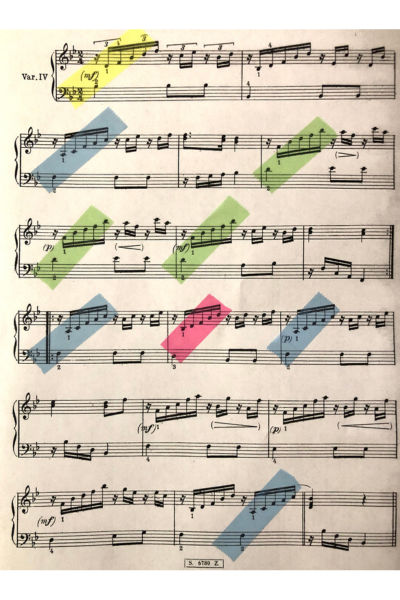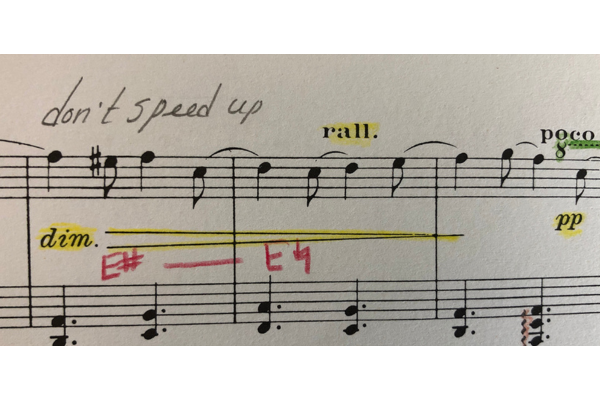
Most of us remember learning about the five senses—taste, touch, sight, hearing, and smell—when we were children. As musicians, we value our sense of hearing immensely. Our ears were likely the first conduit of our interest in music and our love of the harp.
Our sense of touch also plays a significant role in learning to play the harp, and we generally use a combination of our senses to facilitate any learning process. Certainly, Turlough O’Carolan, the famous blind Celtic harper from the 17th–18th century, proved that the harp can be played without the benefit of sight. However, most of us rely greatly on our sight when learning to play the harp. Studies show that 65 percent of people are dominantly visual learners, utilizing visual observations to transmit information to the brain.
As an adult learner, I am willing to utilize anything that supports my learning process. If there is a note dangling at the end of a pile of ledger lines, I have no compunction about writing in the letter name of that note. There is a sense of ease when seeing my own handwriting on my sheet music—the familiar can have a calming effect, which thereby reduces tension. We all know that decreasing tension in the body often allows for improved tone, and can help prevent physical injury.
I find that using color helps me learn music more quickly. I utilize colored pencils, colored arrows, and colored highlighting tape that goes on and off easily and is transparent enough to see through.

You are likely to come up with your own preferences for how to use color to train your eyes and brain, but I will share some of the ways I have found these tools to be most helpful.
When analyzing a piece, I look for repetitive phrases and chords. If a challenging chord appears multiple times, I might opt to shade it (with a colored pencil) the same color every time that it appears throughout the piece. When it appears, I don’t overthink it, instead I remember that I’m already acquainted with this “blue colored chord” and thereby, I recognize it more easily. If I do this with multiple chords, choosing one color to represent a specific chord whenever it appears helps to distinguish it from other chords that are shaded as pink, green, etc. Similarly, I will use a specific color of highlighting tape and place it over a couple of measures and then apply the same color highlighter tape to those measures that appear elsewhere in the piece. When I approach these highlighted measures, I know that I have already encountered them and know them. Because this highlighter tape is removable, it is akin to training wheels on a bicycle—eventually I don’t need them on my sheet music and I peel them off with no damage to the underlying paper.
When I write in my pedal changes, I opt to use red pencil (see example at the top of the following page). This way they jump off the page at me so that I am prepared for these accidentals before I even get to them. If I repeatedly miss a pedal change, I will take a sticky Post-it arrow and point at that pedal change. Once I no longer stumble with this pedal change, I remove the arrow.

I also write directive notes to myself in the margins, like “get right foot ready,” “move fast here,” or “raise,” etc. At a measure that I find tricky or if the tempo is fast, writing in an arrow that points up or down offers a visual cue to quickly alert me as to whether my hands need to move up or down the harp.
I also like to use a yellow pencil to emphasize dynamics that are marked in the music. When learning a new piece, our brains can be overwhelmed by the many concurrent tasks it must perform—reading the music, figuring out note values and rhythms, changing accidentals, etc. Often, this means that dynamics are not incorporated until the very end of the learning process. Having the dynamics colored yellow helps remind me to try to include them sooner rather than later. If the bass clef switches to treble clef in the middle of a line, I might shade that with an orange pencil. My brain sees the colored clef note and is prepared that a shift will be coming up. Likewise, I might use a green pencil to help an 8va notation stand out, allowing me to see ahead and be ready for it.
There are endless ways to use color and fortunately, there are quite a few office supplies that are available. Have fun exploring what colorful aids allow your eyes to assist your hands and your brain. Consider adding some tools for success while making your life just a bit more colorful! •
Talk to us
Sounding Board is a place for your opinion and commentary about harp-related issues. (Opinions do not necessarily reflect those of the Harp Column editorial staff.) Send submissions to: areese@harpcolumn.com.






